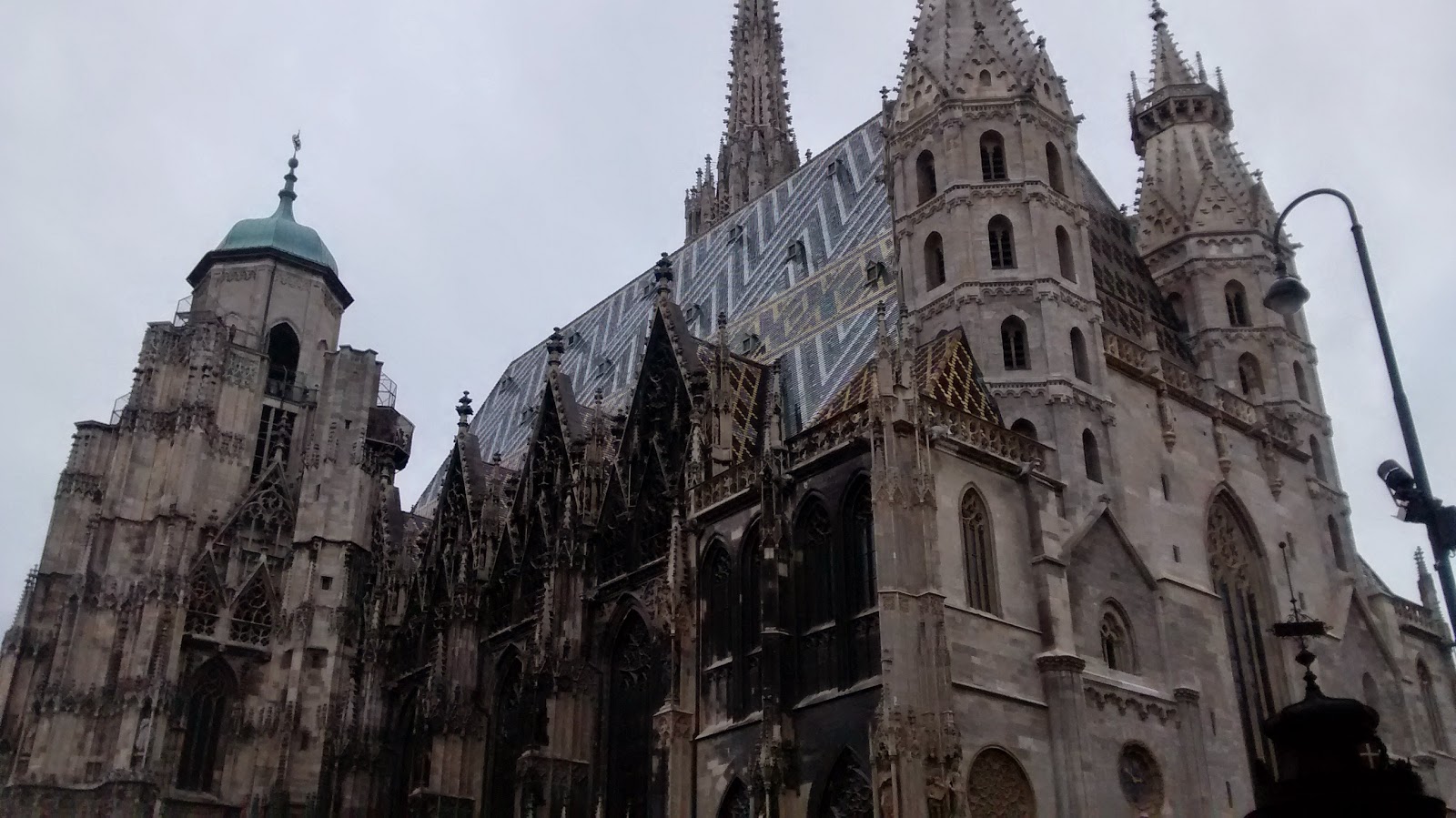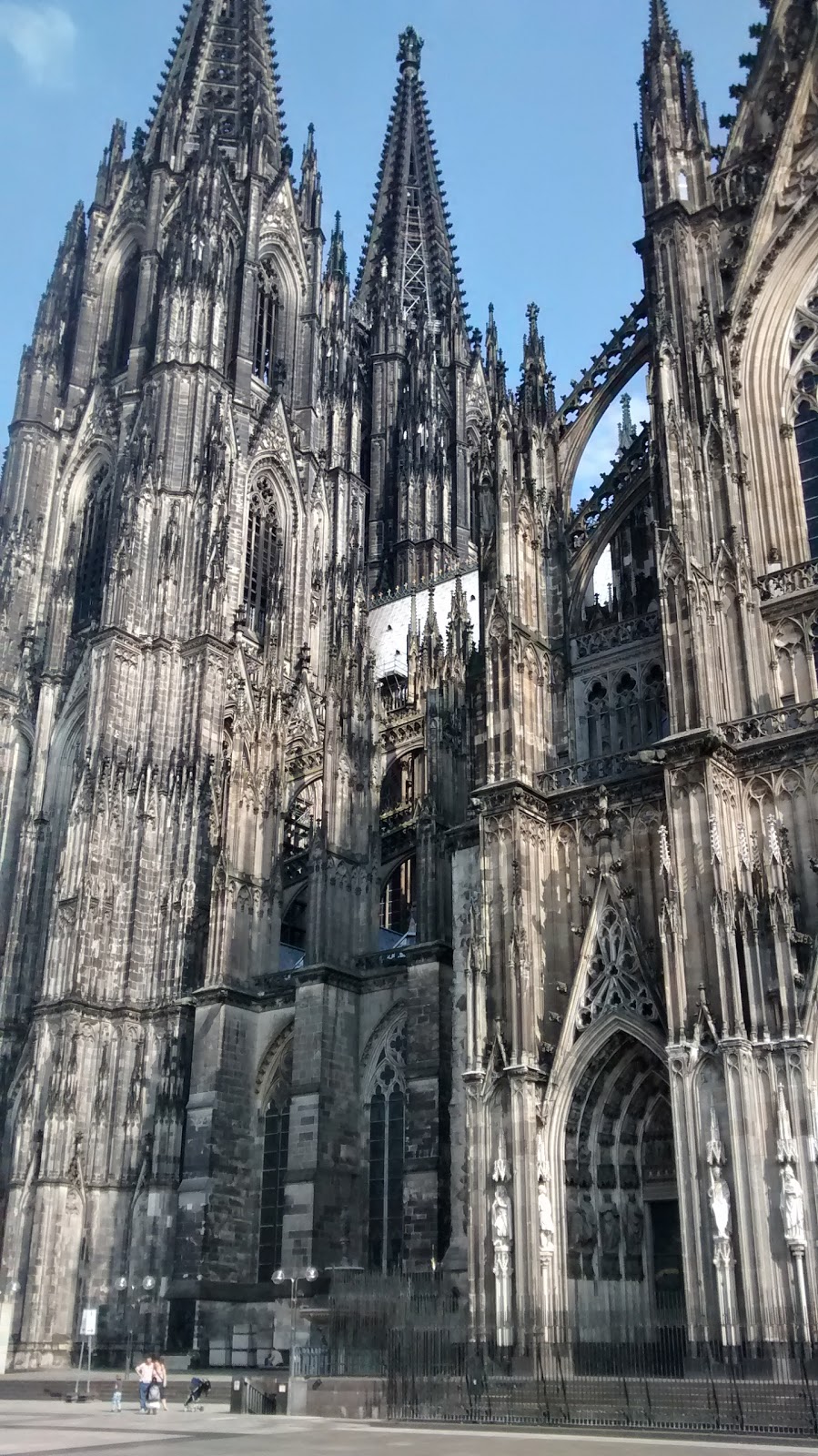 |
| Countryside between Hamburg and Berlin |
My first impression of Berlin began on the bus from Hamburg. On the three hour ride, we encountered endless traffic. Finally, our driver got on the intercom and uttered a statement in German. Then, we were turning off onto a small town and bumping along on country roads. Even with all his attempts, we still reached Berlin an hour late.
 |
| Berlin wall with Luftwafte building behind it |
The next day, I purchased a day pass and braved the metro system to get to the 9 am free walking tour. Arriving at the Brandenburg Gate 10 minutes late, I bounced from tour to tour until finding the free walking tour group at the site where Hitler committed suicide. It is today a parking lot. We continued on to the building that housed the Luftwafte during WWII. It is one of the largest buildings in Berlin from that era; and, it was barely damaged. Today, it houses Berlin's tax office. Next, we stopped at a section of wall that has been preserved to remember the division of East and West Germany. Along the wall, there is currently an exhibition entitled "
Topography of Terror" that describes Germany's campaigns against Warsaw during WWII. It is a sobering exhibit. We walked on to the
Checkpoint Charlie memorial, which does not stand where Checkpoint Charlie actually was (but, close enough). The original wall is marked all around Berlin in the streets with commemorative plaques.
 |
| Concert House |
Our next stop on the tour was a large square flanked by two different churches with a
Concert House in between. One of the churches was built for the
French Huguenots, who made up a quarter of Berlin's population in the early 17th century. During WWII, these three buildings were heavily bombed. The buildings today are reconstructions. However, many of the statues are originals that were removed and protected during WWII. During WWII, books were burned in this square. Today, there is a memorial of empty bookshelves underneath the pavement representing all the books burned. A quote from Heinrich Heine is on a plaque nearby. It translates to "Where they have burned books, they will end in burning human beings." This quote was from the 1800s, long before WWI or WWII.
 |
| Kathe Kollwitz sculpture in Victims of War Memorial |
We passed Humboldt University as we continued our tour.
Humboldt University, named for Alexander von Humboldt, a man (according to the Cologne Chocolate Museum) who helped popularize chocolate in Europe. Famous students who studied at Humboldt include Albert Einstein. The tour continued on to the
Victims of War Memorial. Kathe Kollwitz created the central sculpture of a mother cradling her son. In this memorial, an unknown concentration camp prisoner and an unknown soldier are buried. As we continued on, we passed something that I found even more interesting than finishing the tour, the German History Museum.
 |
| Albrecht Durer potrait of Charlemagne |
A day in the
Germany History Museum wouldn't be enough. Two hours didn't even scratch the surface. I spent most of my time in the section of pre-1500 Germany. There was a large map that showed how different people groups spread across Europe. A beautiful painting by Albrecht Durer in the 15th century stylized Charlemagne, who reigned over Germany as part of the Roman Empire in the 800s. After visiting so many Catholic churches on my travels, it was intriguing to learn about the Reformation and Martin Luther. The German Museum even has the portraits painted by Lunas Cranach of Martin Luther and his wife. Did you know that there were Bibles translated into German before Martin Luther? Some of these Bibles were on display, as was an announcement from 1517 showing Martin Luther nailing his 92 thesis to the church door. Regretfully, I had to leave too soon in order to meet my tour group at the Reichstag.
 |
| Inside the Reichstag dome, the mirrored cone that lights the Bundestag chamber |
The
Reichstag is the home of Germany's legislative body, the Bundestag. The Reichstag building was originally built in 1894. However, after Adolf Hitler became chancellor of Germany in 1933, the building was burned (arson). The building wasn't restored until 1973. After the Berlin wall fell in 1989, the first elected Bundestag of both East and West Germany was held in the Reichstag in 1990. The Reichstag was one of the buildings that artists Christo and Jeanne-Claude wrapped before it's latest restoration. The reconstruction included a glass dome that has a cone of mirrors that reflect sunlight into the main legislative hall as well as many other environmentally conscious features. If you return to the Reichstag around 9:30, there is a
movie about it's history that plays at 9:45 and 10:15 pm. It's free and outdoors.
 |
| Currywurst with French Fries (pom frites) |
By this time, I was quite hungry. I walked to Museum Island and sat near the river and enjoyed some currywurst. It's a sausage with a curried type of sauce. This is also about the time that I realized that I am quite sick of sausage and french fries! But, the curry wurst was pretty delicious. I ate everything off my plate.
 |
| Ishtar Gate from Babylon |
My next stop was a museum that came highly recommended from some German friends. The
Pergamon Museum is a collection of architectural marvels. There is a bit of a wait. If you are a planner, you can purchase tickets the day before and choose your entry time. I got in line just before 4:30, at which time they closed the gate for any further people. (The museum is open until 6.) Audio guides are included in the price of admission (12 Euros). When I was finally situated with ticket in hand in audio guide attuned, I ascended to the first floor of the exhibit. On the right side, glazed brick of blue and green loomed to the ceiling! It was an amazing sight to behold. These were the bricks from the
Ishtar Gate of Babylon from 570 BC! None of my photos do the gate any justice. And, this is just the smaller gate. The larger gate that was behind this isn't even on display.
 |
| Pergamon Altar |
However, the Ishtar Gate is not the only architectural treasure in the Pergamon. There is an entire room that is filled with a 2nd century BC
temple excavated from Pergamon, Turkey. The friezes from around the temple adorn the room walls. You climb the original stairs between two little platforms, replete with friezes, to reach the top altar. Walking up and down the steps is a bit of a time warp. It's amazing to have the entire altar area reconstructed within the museum room! The Pergamon houses other monumental architecture works. If you only have a chance to visit one museum in Berlin, I highly recommend the Pergamon.























































